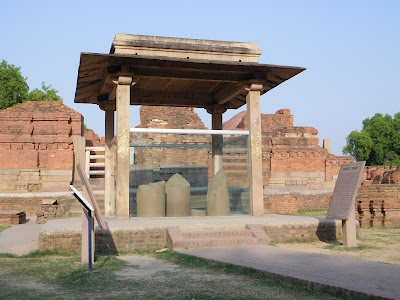Sārnāth
is a small village on the outer part of the city of Vārāṇasī in the northern
India. The term “Sārnāth” derived from Mrigadava, Migadāya, Rishipattana, and
Isipatana which were the diverse names to indicate to Sārnāth. In which
Mrigadava means “Deer Park”, and Isipatana is used in the Tipiṭaka as the place
of holy men.
The
Chinese pilgrim Xuanzang quotes the origin of Migadāya in the Nogrodhamiga
Jātaka. Deer Park was considered as a forest which given the name by the king
of Benares. In that place, deer allowed to wander without harm by human being. In
Sanskrit term “Sarnarth” derived from the word Sāranganātha, which means “Lord
of the Deer”. Bodhisatta is mentioned in the Buddhist story as a king of deer
host, Lord of deer knew a mother deer has the baby, and the one was going to
kill by the order of King. Thus, he offers his life to a king instead of female
deer. When Emperor gave up killing animals after the knowing that matter, and ordered
his citizen to protect the deer species. The great king also created the park
as a sanctuary for deer. Nowadays, if visitors come to Sārnāth, they will see
deer species still living safety in this area.
According
to the Buddhist account, the Buddha spent seven months in Bodhgaya after the attaining
of enlightenment. He walked so far from Bodhi Tree to the Deer Park to preach
the first sermon for five ascetic monks whom became the first disciples after
listening of his teaching. In this event, the Buddhist Order was found from the
five monks. The first sermon was called the Dhammacakkappavattana Sutta (Pali
Sutta), Dharmacakrapravartana Sūtra (Sanskrit Sūtra), The Setting in Motion of
the Wheel of the Dharma Sutra or Promulgation of the Law Sutra (English
Translation). The main topic of this lecture is the Four Noble Truths (cattāri
ariyasaccāni), suffering, the cause of suffering, cessation of suffering, the
way leading to cessation of suffering. This teaching was translated with various
languages, and if visitors come to Sārnāth, they will see the first sermon of
the Buddha with the diverse languages in this area.
Sārnāth
grew into a major center of culture, art, and Buddhist studying after the Buddha’s
passing away. Today, Sārnāth becomes one of the important places of pilgrimage
for Buddhists. There are many Buddhist monasteries established in Sārnāth. In this
way, pilgrims and visitors have more opportunity to experience in the Buddha’s
places.
Chaukhandi Stupa















































No comments:
Post a Comment